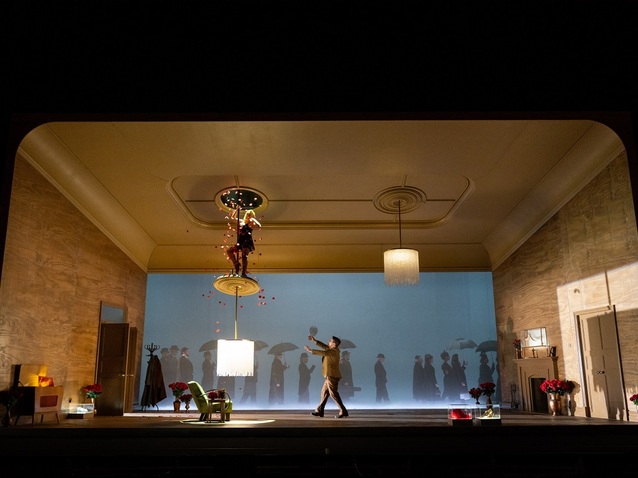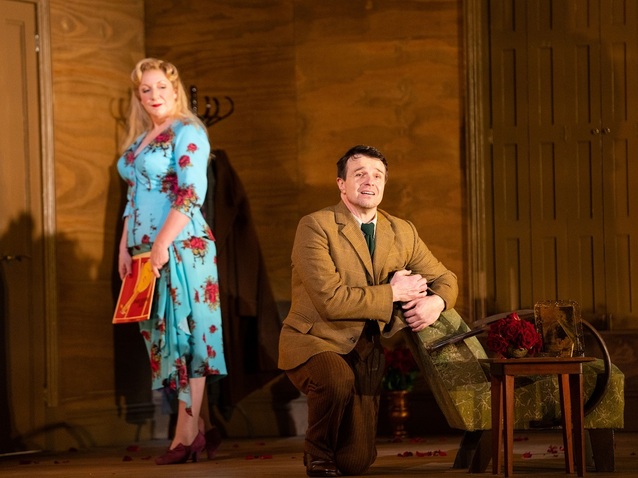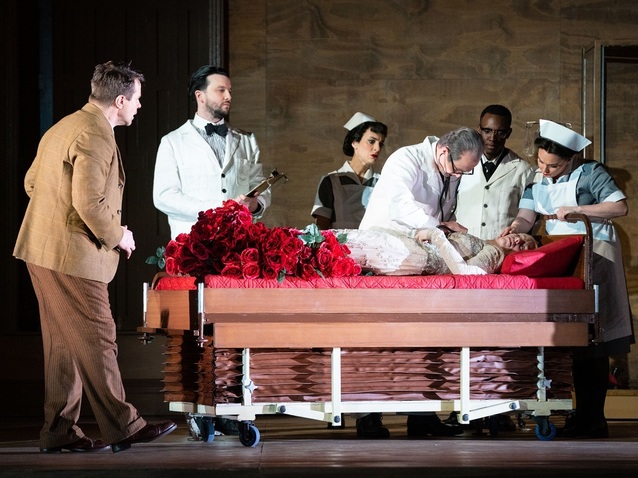 © Helen Murray
© Helen Murray
Erich Korngold, who is more usually if somewhat unfairly associated with film scores, wrote Die tote Stadt at the age of 23. It is based on Georges Rodebach’s 1892 novel Bruges-la-Morte, which had already been turned into a play by the author. Korngold’s father Julius knew Siegfried Trebitsch, who had translated the latter into German, and Julius and Erich adapted the play into an opera, writing the libretto between them under the joint pseudonym of Paul Schott.
Set in Bruges towards the end of the nineteenth century, the story concerns Paul whose wife Marie died several years earlier. On the day in question he is excited to have seen someone who resembles Marie, and who he would like to believe is his wife resurrected. When this woman comes to Paul’s house, it transpires she is called Marietta and is in Bruges as a dancer in an opera company that is staging Meyerbeer’s Robert le diable. She agrees to sing a song for him that Marie used to sing and dances, but soon leaves hinting that he may seek and find her again. Paul then sees Marie’s ghost step out of her portrait, who urges him to admit he is tempted by the other woman.
The events that follow take place as a vision in Paul’s mind. On the streets of Bruges outside Marietta’s house Paul has given into his passion, though he feels immensely guilty about doing so. His housekeeper Brigitta appears as a novice who tells Paul she has left him because of his sin, and then Paul realises that his friend Frank is a rival for Marietta’s affection. Members of the opera company appear and finally Marietta herself, and they begin to rehearse the ballet from Robert le diable in which nuns rise seductively from their graves. With Marietta playing the head nun, Paul cannot stand the spectacle and confronts the group. Marietta and Paul quarrel and Marietta realises that Paul's obsession with her stems from her resemblance to his dead wife. She insists he love her for herself, and back at Paul’s house she plans to break the hold of the dead Marie. Paul continues to be preoccupied with her though, and Marietta starts to taunt him by dancing seductively while stroking his dead wife’s hair. This leads him to strangle her with this lock of hair claiming as he stares at her dead body that now she is exactly like Marie.
As Paul’s vision ends and he comes back to reality, he cannot see Marietta’s body anywhere. Then Marietta, very much alive, returns to his house to collect an umbrella that she left there just a short while earlier. After she leaves, Paul tells Frank that he will not see her again, and Frank announces he is leaving Bruges. He asks Paul if he will come too, to which Paul replies ‘I will try’, thus revealing how he now accepts the need to move on with his life, no matter how hard he may find doing so.

ENO The Dead City 2023, Allison Oakes, Rolf Romei © Helen Murray
Die tote Stadt enjoyed a double premiere, opening in both Hamburg and Cologne on 4 December 1920, and went on to become one of the greatest hits of the 1920s. The work was, however, banned in Germany in the 1930s because of Korngold’s Jewish ancestry, and fell into obscurity after the Second World War. Although it has enjoyed more outings over recent decades, Annilese Miskimmon’s new staging for English National Opera, where it is performed in English as The Dead City, represents only the third fully staged professional production in the United Kingdom, following outings at the Royal Opera in 2009 and Longborough Festival Opera last year.
Miskimmon sets the action at some point in the twentieth century, but the specific time period is less important than the brand of modernity that is suggested by the interior of Paul’s house, designed by Miriam Buether, which feels clean but also sterile. There is a certain deadness that pervades the space, in keeping with the way in which Paul clings to the memory of Marie. Although in the original opera Act II takes place on the streets of Bruges, here all three acts ostensibly occur inside Paul’s house although areas are deliberately mixed up from the outset. For example, at the start Brigitta shows Frank into the Temple of the Past, a locked room that contains keepsakes in Marie’s honour. However, we see the housekeeper predominantly showing him around the main area of the house (although she does indicate this room), with all of the necessary items such as pictures and a lock of hair being in that.
There is a very strong attention to detail as Paul summons local children to bring more roses in tribute to Marie, and Frank quietly turns three away at the door who have made the mistake of turning up with yellow rather than red ones. While suggesting that Paul come to see her perform, Marietta actually leaves a ticket for him, which appears again in Act II, while Paul stroking his cheek with the lock of Marie’s hair is paralleled at the end of Act I when he sees a vision of his wife and similarly feels the hair on her head. When Marietta and then Paul sing ‘Glück das mir verblieb’, known as The Lute Song, there is no physical lute on stage and instead they sing along (in the context of the drama) to a gramophone record.

ENO The Dead City 2023, Rolf Romei, William Morgan, Clare Presland, Hubert Francis, Innocent Masuku, Rhian Lois, Lauren Bridle © Helen Murray
As Act II begins the back wall of Paul’s house is removed to reveal the city outside. Although in the process a generally misty and mystical place is suggested, one is left to wonder if more might have been achieved by exploiting the unique architecture and ambience of Bruges to generate atmosphere. Nevertheless, seeing the indoor and outdoor areas simultaneously has advantages because when the drama involves visions and memories the ability to fuse areas so that there is ambiguity concerning the location is very effective. In the original, Paul imagines a religious procession passing through his house, but this production has all sorts of other things happening inside it as well, such as people arriving down the chimney or through windows. Processions also pervade the action more widely so that Paul relives Marie’s death with her coffin being carried from the house, processed through the streets that we see behind it, and then carried back with Marietta riding on top of it. In a similar vein, the performers from the opera company who appear in Act II are first seen as doctors and nurses crowding around the dying Marie, before their white coats give way to more daring and theatrical fare.
In the opera the same soprano sings both Marietta and Marie, when the latter appears to Paul as a ghost. In most productions, the singer playing Marietta simply appears as Marie at this point, but here Marie is played by a silent double (Lauren Bridle) with her voice coming from offstage. The fact that this Marie does not really look like Marietta may say something about how Paul’s sorrow has led him to see things that defy all logic, but it still feels quite unhelpful for the audience. The whole point of having the same person play the two people is that the uncanny resemblance they bear makes us see things through Paul’s eyes and start to question whether Marietta is not Marie, even though logically we know she cannot be. Seeing the two women appear together in Act III makes sense in that Marietta becomes increasingly annoyed at Paul’s preoccupation with Marie, but having him gaze up at his wife who lies on a suspended coffin somewhat undermines the notion of him seeing Marietta herself as Marie.
Kirill Karabits’s conducting is quite outstanding as it captures all of the textures, colours and movement in Korngold’s enigmatic score, while ensuring that the output always feels impeccably balanced. On opening night it was announced that Rolf Romei playing Paul had been ill in the preceding days, though he would still sing. His tenor feels very suited to this most challenging of roles, possessing a lightness of touch that means it can achieve the right results without any sense of histrionics. On this occasion, the strain did show in a few places, and when he is fully recovered it seems likely that his voice will give everything more presence because his overall persona already seems highly appropriate for the part. Allison Oakes’s portrayal of Marietta initially comes across as a little too straight forward in that, although the whole point of the character is she is very much alive and well, it is surely the sense of mystery that surrounds her that convinces Paul she may be Marie resurrected. However, she soon gets into stride and as the evening progresses her singing becomes thrilling as her voice’s sumptuousness and passion really come to the fore. Sarah Connolly is quite simply luxury casting as Brigitta while Audun Iversen, with his extremely strong and secure baritone, delivers a storming performance as Frank, who in this production becomes a priest. There is effective support from Rhian Lois as Juliette, Clare Presland as Lucienne, Innocent Masuku as Gastone, William Morgan as Victorin and Hubert Francis as Count Albert, while the excellent contributions of the Chorus of English National Opera and the Finchley Children’s Music Group put a seal on what is ultimately a highly persuasive evening.
By Sam Smith
The Dead City | 25 March - 8 April 2023 | London Coliseum
the 28 of March, 2023 | Print
Comments